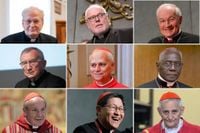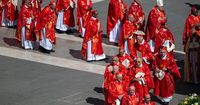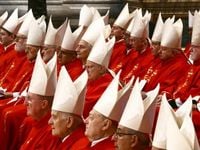As the formal mourning period for Pope Francis has ended, attention now shifts to the papal conclave in Vatican City, where powerful members of the Catholic Church are converging to elect the next pontiff. Cardinals from around the world will choose the 267th pope, leader of the world’s 1.4 billion Catholics, at an event of spiritual, political, and global relevance. Francis died on April 21 at the age of 88 after 12 years in the papacy.
The conclave, which will kick off on Wednesday, May 7, 2025, will be held behind the closed doors of the Sistine Chapel. It generally lasts several days and, in some cases, weeks. Here is what we know:
The term conclave comes from the Latin term “con clavis,” meaning “with a key,” a reference to the tradition of locking the cardinals away until a new pope is elected. In the Roman Catholic Church, a papal conclave is a solemn, closed-door gathering of the College of Cardinals held to elect a new pope. Known as the “princes of the church,” the cardinals follow an intricate and centuries-old process rooted in the Middle Ages. While the traditions have evolved, the current procedures are largely based on the 1996 apostolic constitution Universi Dominici Gregis, issued by Pope John Paul II with later amendments made by Pope Benedict XVI. Cardinals below the age of 80 vote, although all cardinals may attend the meetings irrespective of age. There are currently 135 eligible voters.
In the Roman Catholic Church, the pope is regarded as the successor of St. Peter, the chief of Jesus’s apostles and the first leader of the early Christian church. As such, the pope holds supreme authority over the worldwide Catholic Church in matters of faith, morals, governance, and discipline. The pope is the spiritual leader of Catholics around the globe, supported today by 252 cardinals. “While Pope Francis emphasized that true power comes from Jesus Christ and that he is merely a disciple, the pope is undeniably a powerful global figure,” said Father Francis Lucas, a Catholic priest and executive director of the Catholic Media Network.
The papal conclave is scheduled to begin on Wednesday in the Sistine Chapel, following the traditional nine-day mourning period for Francis. The day begins with “Pro Eligendo Pontifice,” a public Mass in St. Peter’s Basilica led by the dean of the College of Cardinals at 10 a.m. (08:00 GMT) on May 7, 2025. In the afternoon, the 135 cardinal electors gather in the Pauline Chapel near the Sistine Chapel and chant the Litany of the Saints, seeking the intercession of all the holy men and women who have gone before them to pray for the success of the conclave.
After taking an oath of secrecy, the phrase “Extra omnes!” (“Everyone out!”) is declared, and the chapel is sealed. Only the electors and essential staff remain, cut off from the outside world. Voting after the first day occurs a maximum of four times: twice in the morning and twice in the afternoon. Each cardinal receives a ballot marked “Eligo in Summum Pontificem” (“I elect as Supreme Pontiff”) and writes in their chosen candidate. A two-thirds majority is required to elect a pope. If no one reaches that threshold, another vote is held. After each round, ballots are burned. Black smoke signals that no pope has been chosen, while white smoke indicates the Catholic Church has a new pontiff.
The upcoming conclave has already seen four frontrunners emerge: Cardinal Pietro Parolin, Cardinal Peter Erdov, Cardinal Jean-Marc Aveline, and Cardinal Pierbattista Pizzaballa. However, there are many other potential candidates, including Cardinals Cristóbal López Romero and Robert Prevost, who could also rise as dark horse alternatives. The uncertainty surrounding the conclave is heightened by the diverse backgrounds of the cardinals, many of whom do not know each other well.
“The Catholic Church is a church that has to understand how to be one church globally which is united on fundamental things but has to do things differently in different contexts,” said Massimo Faggioli, a professor in the Department of Theology and Religious Studies at Villanova University. This reflects the challenges that the conclave will face, especially after Pope Francis reshaped the College of Cardinals during his papacy, emphasizing global representation and a pastoral focus.
Each of the frontrunners brings a distinct vision to the table. Cardinal Parolin, the Vatican’s Secretary of State, is seen as a moderate candidate who could appeal to both sides. At 70 years old, he has been a steady hand in the Vatican bureaucracy and is known for his diplomatic skills. “It is hard to know if he really is the main candidate because the group of cardinals are very difficult to read,” said a well-placed Vatican insider.
Cardinal Erdov, a conservative figure from Hungary, is known for his strong stance on issues like marriage and immigration. He has been vocal against allowing divorced Catholics to receive communion, which may resonate with traditionalists. Meanwhile, Cardinal Aveline from France is gaining traction among moderates, being described as a “liberal figure, but one inclined to consensus.” His ability to promote interfaith dialogue makes him a strong candidate for a church looking to bridge divides.
Cardinal Pizzaballa, the Latin Patriarch of Jerusalem, is also a formidable candidate. His experience in the Middle East and his diplomatic skills could position him well to lead the Church during turbulent times. His recent offer to act as a hostage in exchange for kidnapped children highlights his commitment to peace and dialogue.
As the conclave approaches, the cardinals will need to navigate their differences and decide on a path forward for the Catholic Church. The challenges are significant: declining attendance in the West, growing secularism, and ongoing scandals surrounding sexual abuse. “The Roman Catholic Church of the 21st century is coming to grips with what it means to be a global church,” Mills said.
After a new pope is elected, he will first accept the role and choose a papal name reflecting his vision or inspiration. The new pope then changes into white papal vestments in the “Room of Tears,” where many newly elected popes are overcome with emotion. Shortly after, the senior cardinal announces “Annuntio vobis gaudium magnum; Habemus Papam!” (“I announce to you a great joy; we have a pope!”) from the balcony of St. Peter’s Basilica, and the new pope steps out to give his first public blessing.
The upcoming conclave is poised to be one of the most unpredictable in history, with the potential for significant shifts in the Catholic Church’s direction. As the world watches, the cardinals will be faced with the daunting task of electing a leader who can unify a diverse global church and address the pressing issues of the modern world.



